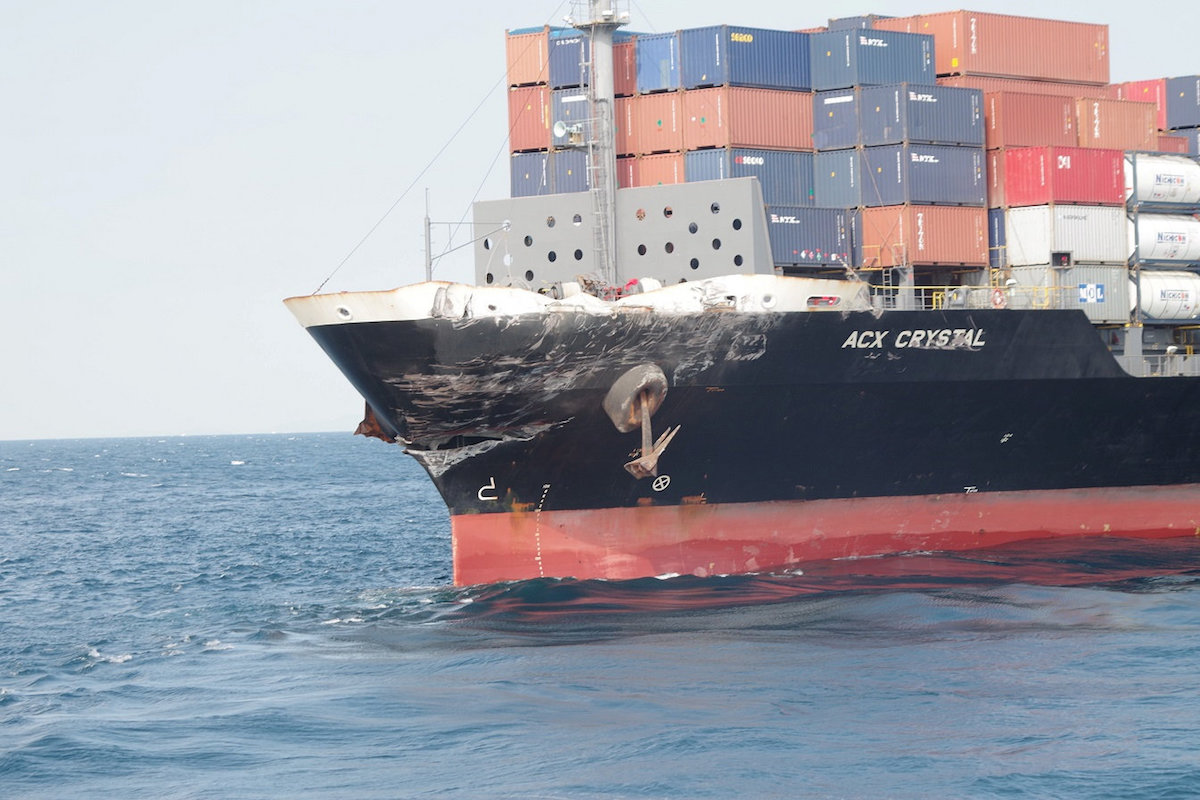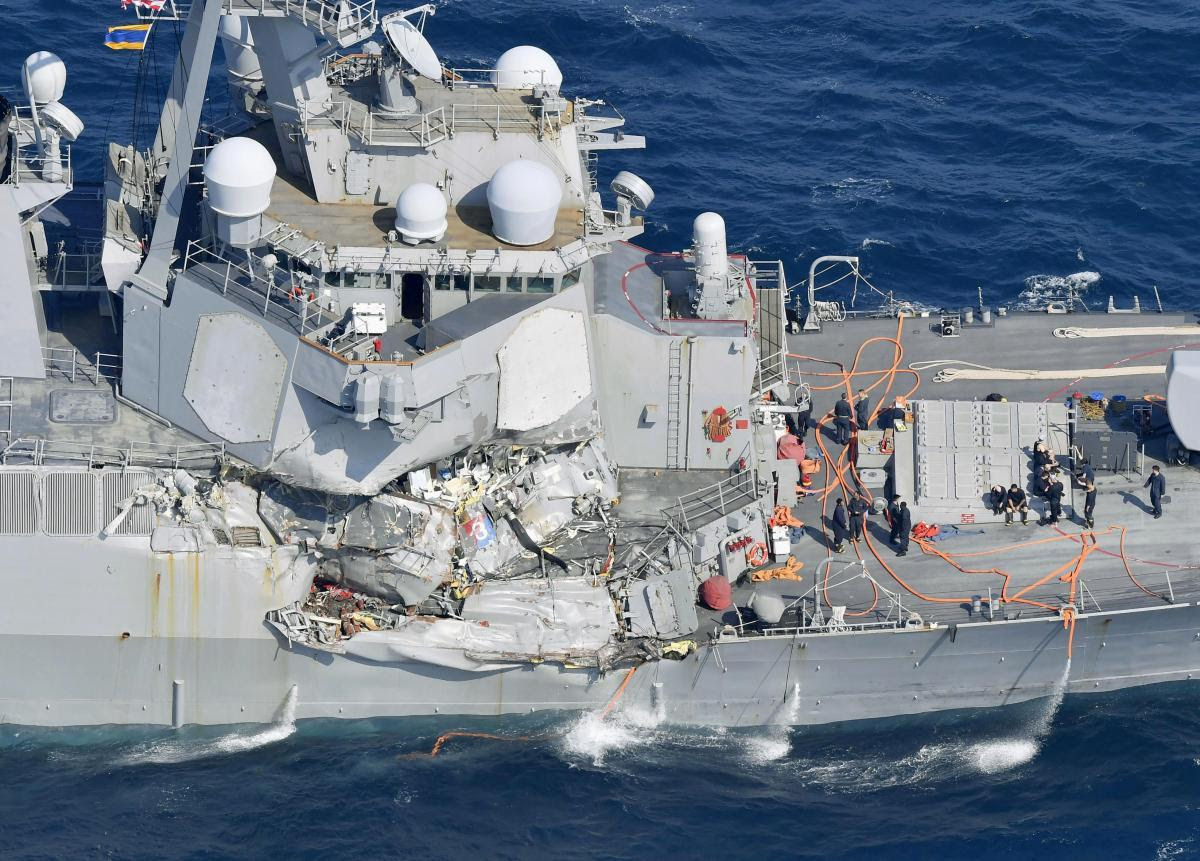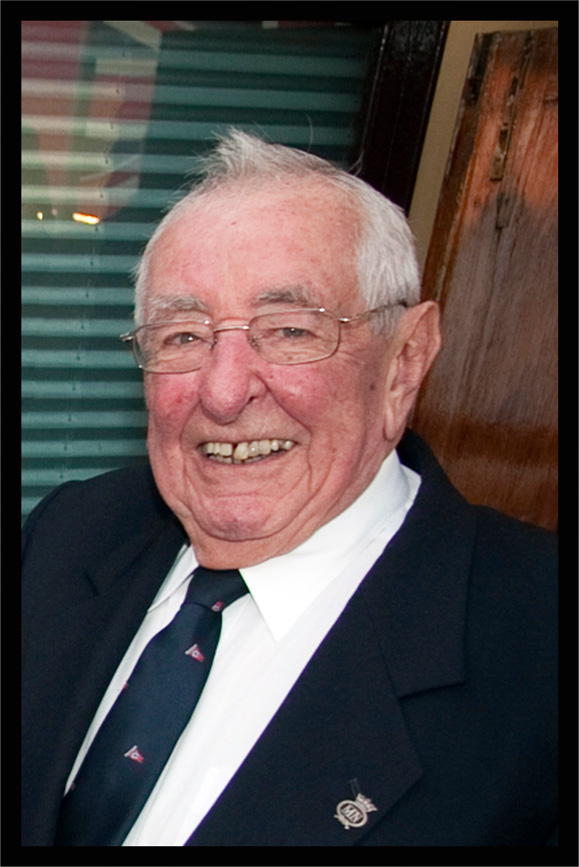By Captain John Konrad (gCaptain)
Every ship, regardless of nationality or purpose, is required to carry one terse book. This book is titled the International Regulations for Preventing Collisions but is better known by its acronym “COLREGS”. The chapters are short and to the point and ship officers are required to make marks of 90% on COLREGs tests taken to keep up their licenses. In order to pass this stringent requirement sailors have developed mnemonic aids to help them remember the contents. When the crew loses control of steering, the COLREGs demands that the ship display two red lights in a vertical line. The mnemonic for this rule is “Red over Red, the Captain’s dead”. Sailboats are required to display a red and green light and its said “Red over Green, sailing machine”. There are many more like this but one important rule for avoiding collisions with Navy warships is missing: “If it’s grey stay away.”
While the media, with a very little hard data, attempts to understand the erratic maneuvers of the containership ACX CRYSTAL on the night of her collision with the Destroyer USS FITZGERALD, professional mariners are certain that a long investigation will find the US Navy ship at fault.
Is this conclusion the result of professional arrogance? Or maybe because of resentment and jealousy over the fact that Navy captains are praised and decorated by the public and media while merchant ship captains live mostly unnoticed. Or is it because they are correct?
As a ship captain along with years working with the U.S. Navy both aboard ships and ashore – here are the reasons why I believe they are correct. The USS Fitzgerald was at fault.
Despite recent advancements in electronic collision avoidance tools like automatic identification systems (AIS), the three most important tools for avoiding a collision are a Captain’s eyes, tongue and ears.
Eyes looking out the windows of his ship, are important because they can process information – like erratic course changes – faster and more accurately than electronic RADAR and charting systems.
A tongue because the quickest and most effective way to predict how a ship is going to maneuver in the minutes before a collision is to call the Captain of the other ship on the VHF radio and ask.
Ears are important because language barriers and cultural differences are prominent at sea and you must listen intently to the other ship’s reply if you want any chance of understanding her intentions.
The USS Fitzgerald’s Captain used only one, or possibly none, of these tools when communicating with the ACX Crystal.
In the moments leading up to a collision a merchant ship captain has to do everything but steer the ship himself. With the help of one officer he has to watch the RADAR and AIS, plot the relative courses of nearby vessels, communicate with the Engine Room, talk with other ships on the VHF radio and issue orders. But on a navy ship each of these jobs is performed by a small team of sailors who report changes to, and obey orders from, the officer of the deck (OOD). The OOD relays the important information to the Captain.
This system of many team members – each working on equipment they have been very well-trained to operate and reporting through a command structure that filters all but the most important information to the captain – is highly effective in war when a warship is exchanging salvos of high speed torpedoes and missiles with numerous hostile targets (anyone doubting this should read Jeff Edward’s excellent book “Torpedo”). But this structure is ineffective when dealing with a single, slow moving, merchant ship.
An eye on the target and direct communication – Captain to Captain – is the most effective means of avoiding collision but this never happens on Navy ships. When a merchant ship attempts to call a U.S. Navy warship he first has to establish contact. Calling another merchant ship is relatively easy, you find the name of the ship on your AIS and hail it on the VHF. But the US Navy often turns off its AIS transmitter to prevent an enemy from tracking warships via internet sites like MarineTraffic.com which pick up the AIS signal via commercial satellites and publish the positions online.
The alternative way to contact a Navy ship is by calling out its hull number (painted in huge white numbers on the bow) but, for various reasons, the Navy doesn’t always respond to this number.
Provided you do establish contact with the oncoming destroyer you run into another major obstacle. The person who responds to your call is not the Captain but a junior enlisted radioman who relays the message to the Communications Watch Officer who then relays the message to the Officer Of The Deck who relays it to the Captain. The Captain’s response then has to go back down the chain where time and information is lost, mistakes are made and the delays occur. Hard data is, more often than not, conveyed accurately, but more nuanced information – like the sound or anger, hesitation or exhaustion in the captain’s voice – is lost.
The communication problems don’t stop there. Navy ships require that information from complex systems move quickly between officers and they carry this out with a large vocabulary of acronyms, abbreviations and units of measurement that are highly effective for communication between American naval officers but are gibberish to foreign ship captains.
For example… a foreign ship captain will order his helmsman to turn port or starboard but an American captain orders left and right turns. Merchant Captains prefer true bearings based off the compass but Navy Captains prefer relative bearings based off the centerline of his own ship. And most frustrating of all, merchant mariners use Nautical Miles to denote distance but the Navy measures everything in yards.
Small differences? Maybe but a series of small discrepancies can lead to big problems.
Was VHF contact established between the two vessels before the collision? Why was the USS Fitzgerald Captain in his stateroom and not on the bridge looking out the window? Was he tuned into the VHF radio monitoring the conversation? Was the containership captain fluent in English and, if not, did the navy radioman listen with patience and speak with simple clarity? Did they communicate externally with international accepted standards or use U.S. Navy centric jargon?
This is important because basic communication problems have been found to be a primary cause in nearly every multi-vessel incident gCaptain has reported on in the last ten years.
In the not so distant past, merchant ship captains holding a “Master Unlimited” license, the highest license issued by the Coast Guard, were legally sanctioned to command any ship of any size upon oceans. The only limitation placed on that license was large sailing ships (Tall Ships). While that is still technically true today, a containership company would not hire a tanker captain and a cruise ship company would not give a large cruise ship to a containership captain. They want people having experience aboard similar types of ships.
It takes a bachelor’s degree from a Marine Academy plus approximately 10 years and the completion of intense testing to earn a Master Unlimited license. There are ways around some of these requirements (like having a college degree) depending on the flag state, but all maritime nations have strict rules governing how many days of those 10 years were spent at sea. A civilian ship captain will spend at least a few hours on the bridge of the ship every day of work. That translates to a lot of experience avoiding collision.
The U.S. Navy also has specialized strict standards for enlisted sailors. If you want to operate a RADAR, for example, you must pass general examinations, be selected, attend the Navy’s challenging “A” school and commit to a five year service obligation. Then enlisted sailors have to prove their ability aboard ship under the watchful eye of non-commissioned officers.
Each individual piece of critical equipment aboard a navy ship has a highly trained and competent person(s) assigned to it. The total number of people working, on both the bridge and the Combat Information Center (CIC) to navigate the ship exceeds a dozen.
The merchant ship captain, who has to operate all equipment himself, often has to use his experience and expertise to fill in gaps of information. But the Naval officer has the opposite problem. He is often working with too much information as it comes in from all the enlisted people who work for him… and he has to use his knowledge and experience to filter out unnecessary data. The question is, how much experience does he have?
The captain of a merchant ship does not work in an office, he never gets sent to the engine room to stand a watch, and with just two dozen people aboard his ship at any one time he is free of most of the administrative and disciplinary duties that come with commanding a Navy destroyer with five times the number of sailors.
But unlike the merchant captain and the enlisted specialists working on navy ships, the U.S. Navy Captain and his bridge officer (OOD) are generalists. A large percentage of their careers are spent working shore side jobs and their shipboard time was spent rotating through positions: the engine room, the combat information room, in administrative positions and elsewhere.
In short, the merchant ship captain and bridge officers have significantly higher number of hours spent on the bridge then their naval counterparts.
One myth that persists among the general public is that Captain Joseph Hazelwood, master of the Exxon Valdez, was drunk at the wheel of his ship when she grounded on Bligh Reef. The truth is far different.
Captain Hazelwood rightfully shouldered the blame for that incident because a Captain is responsible for the actions of his crew but his level of intoxication, if any (blood alcohol tests were inconclusive) was found not to be a primary cause of the incident. How could it be? He was not on the bridge of the ship when it grounded. He was in his cabin! The ship was grounded not by Hazelwood but by a junior officer he trusted to navigate the ship safely.
Ship Captains never take the wheel and drive the ship, helmsmen and autopilots do that job. Ship captains spend most of their time in the office doing paperwork or managing people all around the ship. The actual navigation of the vessel is done on the bridge by a junior officer called the Officer In Charge Of The Navigational Watch (OICNW). The US Navy operates the same way but that officer is the Officer Of The Deck (OOD).
It is this officer’s duty to navigate the ship safely according to the voyage plan laid out by the captain. This officer is in charge of communicating with and avoiding other ships. He is the one responsible for avoiding collisions and he holds this responsibility with important caveat; it is his duty to call the captain whenever there is possible risk of collision or danger of any kind.
And it is the Captain’s duty to go to the bridge whenever he is called for help.
But the captain of the USS Fitzgerald, like Captain Hazelwood, was not on the bridge. He remained in his cabin where he was injured during the collision. Did the OOD fail to call him up to the bridge for help managing the situation? Did he ignore the OOD’s call for help? Or, like the Exxon Valdez, did the bridge team not realize they were in trouble until it was too late?
Either way, a major error was made by someone aboard the USS Fitzgerald.
Let’s take a quick look at just some of the resources the USS Fitzgerald’s captain had at his disposal prior to the collision.
The USS Fitzgerald is an Arleigh Burke class destroyer with a top speed well in excess of 30 knots. Speed is helpful in preventing collision because it allows you to put more distance between you and a dangerous ship in the same amount of time. (Yes, speed can also be dangerous.)
She is powered by four gas turbine engines with over 100,000 horsepower available to turn her propellers. Gas turbines are expensive and burn lots of fuel but the Navy uses them because they can provide an immense amount of torque in a very short period of time. Torque translates to acceleration and acceleration is important if you need to get out of the way of something fast.
The Arleigh Burke class destroyer has highly advanced AN/SPY-1 three dimensional RADAR, variable pulse width surface RADAR, AIS transceivers and a hull mounted sonar array tied into an Electronic Warfare Suite capable of tracking objects of small size moving at a high speed in real time.
The USS Fitzgerald is highly maneuverable with a very tight turning radius.
The AXC CRYSTAL however has a theoretical top speed of about 20 knots but is rarely pushed that fast.
She has a single 8-cylinder diesel engine capable of pushing one propeller with 29,200 horses for 3/10ths the amount of power of the destroyer. The acceleration of a ship like this is measured in miles, not minutes like the destroyer. Diesel engines like hers are the size of a modest house and are locked into a certain speed at night. The bridge officer can cut speed immediately but at the risk of damaging equipment. Changing speed safely requires that the engineers wake up, change into work clothes and walk down to the engine room to check the equipment before moving the throttle.
She has two RADAR sets of modern design that is likely able to overlay digital charts. Said RADAR system requires a minimum of 3 minutes of pinging to properly calculate another ship’s change in course and/or speed.
She also has an AIS receiver that plots the position, course, speed, rate of turn and other useful information on the RADAR display in (close to) real time. In turn, her AIS system transmits her information to other ships including warships. She must, by law, transmit this information at all times. Her AIS unit does not, however, receive any data from Navy ships who cloak their positions.
She weighs four times as much as the destroyer. She can also stop and turn on a dime… but only if that dime is owned by giants and has a diameter measured in nautical miles.
She has 8 officers, a captain and around a dozen unlicensed sailors… versus the destroyer’s 33 officers, 38 chief petty officers and 210 enlisted sailors.
The media has been publishing reports on “crazy ivan turns” and erratic behavior all based on incomplete and one sided AIS data which cannot yet be correlated with the exact time of collision. It is too early, and information too scant, to publish a list of her faults.
That said, she is at fault! Remember the COLREGS? What I failed to mention in the beginning of this article is that, while terse, the book is littered with terms like “safe speed”, “all available means” and “Nothing in these Rules shall exonerate”. These words are nebulous and have remained so for centuries for a reason… so that no captain can ever shirk his responsibility for avoiding a collision. The COLREGS are terse, specific and targeted when it comes to assigning blame but soft and imprecise when it comes to removing responsibility and blame. Thus, every modern admiralty court trial of ships colliding has found fault with both ships, even if one is securely anchored!
Under COLREGS, whenever two ships touch each other, both ships are to blame.
For this reason, I am 99.9% confident the USS FITZGERALD will be found at fault… and so will the ACX CRYSTAL.


 Reports in the immediate aftermath of the collision commented with some surprise at the contrasting sizes of the two ships, although the warship was a medium-sized vessel and the 2008-built Philippines flag containership was, at 2,858 teu, what might be described as a medium-sized vessel working Asian regional trades, on the Asia Container Express service. It was also noted that a powerful warship was probably more manoeuvrable than the larger container vessel, although the latter has a 25-knot service speed.
Reports in the immediate aftermath of the collision commented with some surprise at the contrasting sizes of the two ships, although the warship was a medium-sized vessel and the 2008-built Philippines flag containership was, at 2,858 teu, what might be described as a medium-sized vessel working Asian regional trades, on the Asia Container Express service. It was also noted that a powerful warship was probably more manoeuvrable than the larger container vessel, although the latter has a 25-knot service speed.